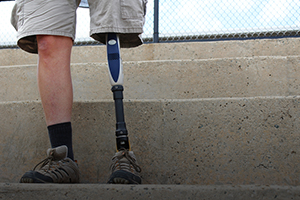Prosthetic Limb Control

A common challenge for amputees wearing prosthetic limbs is the inability to sense the limb position. That’s because the muscles and nerves which enable proprioception – the dynamic relationship that provides feedback between your body and your brain – are typically tied to bone when a portion of a limb is removed. But a new technique was recently described in which new muscle pairs were grafted onto the amputation site in a below-the-knee amputation. Electrodes applied to the skin monitor the muscle activity and control the motors in the prosthetic, while sensors in the foot of the prosthetic transmit information back to the muscles. The result is a system of artificial proprioceptive feedback that can restore near-normal gait control to the wearer.
The patient experienced some reflexive behaviors that have never before been observed with a prosthetic device, such as unconsciously flexing the foot when climbing stairs and being able to interpret the sensations of position, speed, and force to control how hard to push a pedal. The new technique could someday help many amputees better navigate difficult terrains and alleviate sensations associated with phantom limb.
For information: Hugh Herr, Massachusetts Institute of Technology, Program in Media Arts and Sciences, 77 Massachusetts Avenue, Cambridge, MA 02139; phone: 617-28-6574; email: hherr@media.mit.edu; Website: http://biomech.media.mit.edu/#/